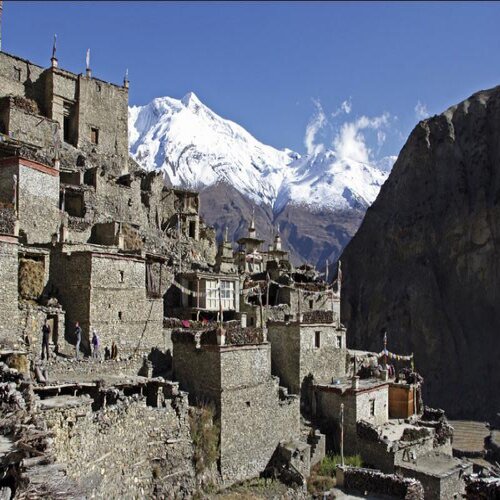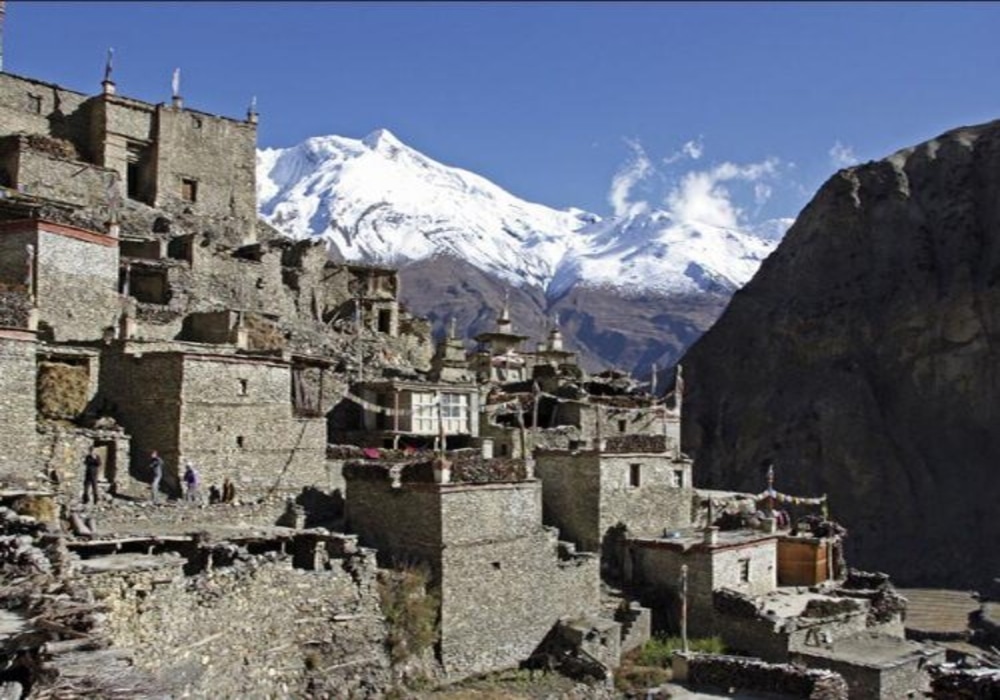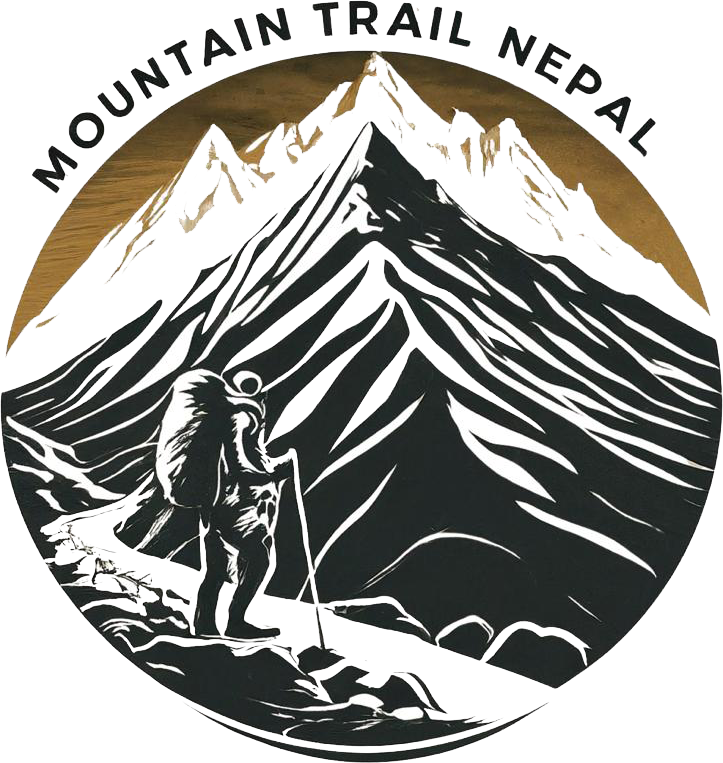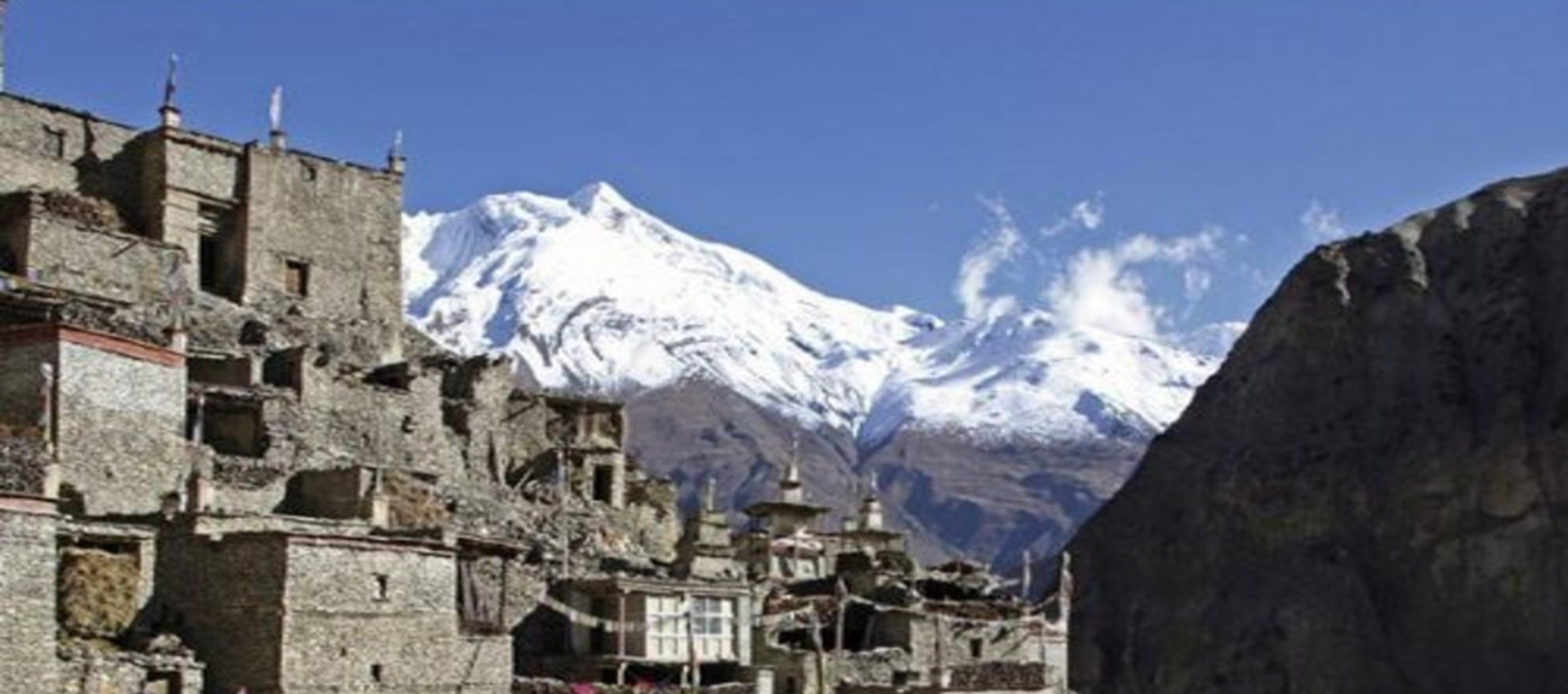Nar Phu Valley Trek
The Nar Phu Valley trek is an adventure that explores the hidden gems nestled between the Annapurna and Manaslu regions of Nepal. This trek takes you to the remote villages of Nar and Phu, inhabited by Tibetan refugees known as Khampas. You’ll have a unique opportunity to immerse yourself in their medieval Tibetan culture and visit ancient monasteries.
During the trek, you’ll encounter breathtaking landscapes, including snow-capped mountains, deep gorges, and narrow canyons. You’ll also have the chance to spot yaks and blue sheep roaming freely. The trek is challenging, so it’s important to have a good level of fitness. Additionally, a special permit is required to enter the hidden valley.
The journey begins with an 8-9 hour bus ride from Kathmandu to Jagat, followed by a trek along the Annapurna circuit trail to Meta. From there, you’ll cross a bridge over the Marshyangdi River and enter the Nar Phu Valley. Along the way, you’ll pass through alpine villages and explore the scenic Nar Valley before crossing the Kang La Pass.
Afterward, you’ll rejoin the Annapurna Circuit trail and trek to Manang, Yak Kharka, and Thorong Phedi. From Thorong Phedi, you’ll cross the Thorong La Pass, one of the highest passes in the world, and reach Muktinath, a sacred pilgrimage site.
The journey continues to Jomsom and Tatopani, where you can relax in natural hot springs. Finally, you’ll return to Pokhara and then Kathmandu, where the trek concludes.
It’s recommended to arrive in Kathmandu at least two days before the trek for last-minute preparations and to acquire the necessary special permit. Transportation options include a local bus ride or a private jeep for added comfort.
Trip Highlights
- Experience the timeless charm of ancient villages that have preserved their heritage for centuries.
- Marvel at the stunning vistas of the Annapurna massif and Tilicho peak.
- Immerse yourself in the unique culture of the Tibetan plateau, blending seamlessly with Nepali landscapes.
- Engage with local communities, offering a glimpse into their traditional lifestyle and rich cultural heritage.
Trip Itinerary
Expand All
Shrink All
-
Day 01: Arrival in Kathmandu (1300m)
Once you land at Tribhuban International Airport (TIA), a friendly representative from our company will be there to take you to your hotel for the trip. You can take it easy and unwind at the hotel. Afterwards, you’ll join us for a trek briefing with our team members. Then, you’ll spend the night at the hotel in Kathmandu.
-
Day 02: Kathmandu Sightseeing and Trek Preparation
Discover the famous UNESCO World Heritage Sites in the Kathmandu Valley, such as Swyambhunath, also known as the Monkey Temple, Pashupatinath, and Boudhanath. Admire the unique architecture of these structures and explore Kathmandu Durbar Square. After exploring these sites, head back to your hotel. You can use the rest of the day to make final preparations for the trek. Spend the night at the hotel in Kathmandu.
-
Day 03: Drive from Kathmandu to Koto via Besisahar (2610m)
-
Day 04: Trek from Koto to Meta (3560m)
After breakfast, we begin our trek and register our permit at the Police Check Post. We walk alongside the riverbank of Soti Khola, passing through lovely woods, small cave shelters, and resting spots for pilgrims. Along the way, we enjoy our packed lunch. We then continue our trek to Meta village. Meta is located on a large open plain and has a few lodges. From here, we can enjoy excellent views of Annapurna II and Lamjung Himal. We’ll spend the night at a simple guesthouse.
-
Day 05: Trek from Meta to Phu (4050m)
After breakfast, we’ll follow a trail that goes up and down, crossing suspension bridges over streams. In a few hours of trekking, we’ll reach Kyang, where there’s a settlement of Khampa people who fled Tibet. After a few more hours of hiking through beautiful canyons and gorges, we’ll arrive at Phu village. We’ll spend the night at a hotel there.
-
Day 06: Acclimatization at Phu, Hike to Himlung Base camp (4800m)
Today, we have the option to explore Phu village or hike up to Himlung Himal base camp. In Phu village, we can learn about the local culture and enjoy the natural beauty of the area. Spending time with the villagers and watching them spin yak and sheep wool can be an interesting experience.
For those seeking an extra challenge, the hike to Himlung Himal base camp offers stunning views as it takes you through a glacial valley. We’ll spend the night back at Phu village.
-
Day 07: Trek from Phu to Nar Phedi (3500m), Overnight stay at monastery
After breakfast, we’ll head down the trail towards the river, crossing several suspension bridges along the way. One of the bridges we’ll cross is over the Lapche River, which hangs 80 meters above the gorge. We’ll stop for lunch at Mahendra Pul.
After lunch, we’ll continue our trek, passing by many Buddhist monasteries and gompas until we reach Nar. Tonight, we’ll stay at Nar Monastery. You’ll have the opportunity to spend time with the people from the monastery, perhaps watching them prepare dinner over a modest fireplace. Around 5 pm, they usually hold a puja (blessing), and you’re welcome to witness it. We’ll spend the night at the monastery.
-
Day 08: Trek from Nar Phedi to Nar village (4120m)
After breakfast, we’ll climb out of Nar Phedi and follow a winding path up a hill to Nar. Nar is livelier than Phu, and you’ll notice more social activity in the village. You might find the village “square” bustling with women chatting as they weave wool fabric for rugs and blankets on their back-strap looms. We’ll spend the day exploring Nar village, getting a close look at the local culture and lifestyle. We’ll stay overnight in Nar village.
-
Day 09: Trek from Nar village to Ngawal (3650m), via Kangla pass (5240m)
Today promises more adventure as we embark on a long day hike. We’ll start our trek after an early breakfast and make our way to the Kangla Pass. From the pass, we’ll be treated to magnificent views of the Annapurna massif, including Annapurna II, Gangapurna, Tilicho Peak, and the beautiful high-altitude airport in Hongde. After soaking in the breathtaking scenery, we’ll continue our trail down to Ngawal. We’ll spend the night in Ngawal.
-
Day 10: Trek from Ngawal to Pisang, Drive to Besisahar
After breakfast, we start our trek downhill towards Pisang, which marks the final leg of our journey. The trail is wide and easy to walk on, offering spectacular views along the way, including a beautiful lake. Eventually, we reach Pisang, which is the last destination of our trekking adventure. From there, we’ll take a jeep back to Besisahar, where we’ll spend the night.
-
Day 11: Drive back to Kathmandu and farewell dinner
After breakfast at the hotel, we’ll board the bus early in the morning in Besisahar for our journey back to Kathmandu. It’s a fantastic experience as we pass by satellite towns, rural villages, and gushing rivers along the way. After about 6 hours of driving, we’ll reach Kathmandu. Upon arrival, we’ll head straight to the hotel to freshen up and then enjoy a farewell dinner with the representatives from Danphe Adventure Treks. We’ll spend the night in Kathmandu.
-
What's Included
- Private airport transfers in a comfortable vehicle for arrival and departure.
- Accommodation in Kathmandu with breakfast included, as per the itinerary.
- Guided cultural tour of Kathmandu with a knowledgeable guide and private vehicle.
- All meals (Breakfast, Lunch, and Dinner) provided during the trek.
- Comprehensive ground and air transportation arrangements throughout the trek.
- Experienced, English-speaking guide and porter ratio of 1 porter for every 2 trekkers.
- Staff salaries covering their food, accommodation, and transportation expenses.
- Arrangement of all necessary permits, including Conservation entry permits and TIMS card.
- Emergency helicopter service arrangement, covered by your travel insurance.
- Provision of essential trekking equipment, including sleeping bag, down jacket, and trekking map (to be returned after the trek).
- Inclusive of all government taxes, VAT, and local taxes for a hassle-free experience.
- Nepal entry visa fee ($25 USD), obtainable upon arrival at Tribhuwan International Airport in Kathmandu. Please prepare 2 passport size photos.
- International airfare to and from Kathmandu.
- Compulsory travel insurance covering the duration of your trip.
- Meals in Kathmandu, giving you the flexibility to explore local dining options.
- Entry fees for cultural tours and attractions during your stay in Kathmandu.
- Personal expenses such as alcoholic and non-alcoholic beverages, bar bills, battery charges, additional porter services, and hot water showers.
- Tips for your guide, porter, and driver, which are discretionary but highly appreciated for their excellent service
Equipment List
List of Equipments required for Nar Phu Valley Trek:
Head:
- Warm winter hat/beanie
- Sun hat
- Headband/buff
- Sunglasses with UV protection
- Headlamp/Torch with extra batteries
Upper Body:
- Light fleece sweater
- Heavy fleece sweater
- Quick-drying long-sleeved base layer shirts (2 pairs)
- Short sleeve trekking shirts (3 pairs)
- Wind/rainproof jacket
- Down jacket
Lower Body:
- Trekking shorts
- Trekking trousers
- Lightweight thermal bottoms (seasonal)
- Trekking pants with zip-off bottoms (2 pairs)
- Fleece or woolen trousers
- Waterproof pants
Hands:
- Lightweight warm gloves
- Poly-liner gloves
Feet:
- Trekking boots
- Sandals/trainers (for wearing around the lodges)
- Down booties
- Thin lightweight inner socks (2 pairs)
- Warm woolen or poly socks (2 pairs)
- Gaiters (only in winter)
Other:
- Sleeping bag
- Sleeping bag liner (optional)
- Trekking poles (1 pair)
- Water purification tablets/Steripen/drops
- Quick-drying towel
Feel free to adjust this list based on your personal preferences and the specific requirements of your trek. It’s essential to ensure you have the necessary gear to stay comfortable and safe during your adventure in the Nepalese mountains.
FAQs
-
What are the visa requirements?
Currently, all the foreign nationalities (except Indians) require a visa to enter Nepal. Visas are obtainable from embassies abroad or on arrival at Kathmandu’s Airport. If getting the visa at the airport be prepared for long queues. You will also need to provide one passport photo and the $50 USD fee for 30 days.
-
What are the physical requirements for Nar Phu Valley Trek?
Nar Phu Valley Trek requires you to trek at an altitude of maximum Kang La pass (5200m) and up to 5- 7 hours per day, with a small 5-7kg bag. We recommended you to train with long hikes and/or a sport of your choice (e.g. jogging).
-
How old do I need to be?
There is no age restriction for doing this trip, but if you are under 16 it will better to trek with your parents. You must be health-conscious during the trek.
-
What is included?
Included:
- Guides and Porters
- Transportation (including airport transfers)
- Accommodation
- Permits & national park fees
- Sightseeing tour in Kathmandu
- All meal during the trek
- Seasonal fruits
Excluded:
- International flights to Kathmandu
- Food – (while you are in City)
- Showers on Trek
- Tips
- Visa fees (typically $50 USD)
- Personal travel/rescue insurance
-
What is the accommodation like?
You will stay in the Hotel while you are in the city of Kathmandu, which is like a 3-star category. The hotel has access to showers and intermittent internet.
But while you are in trekking Tea House/lodges are the place where you spend the night during the trek, which is very basic. The room is pretty small with twin sharing and a common washroom. Some places have squat style toilets, whilst others have a western style. Shower does not always offer warm water and most teahouses will charge you for use of a hot shower.
-
Which meals are included?
Meals will be served as per the menu of the teahouse/lodges. Where you can find a variety of dishes like Indian, Nepalese, Tibetan, Continental, etc, to choose. Tea, coffee, bakery items, snacks, bars eggs, etc can also be found easily.
-
What currency should I take?
The currency used in Nepal is Nepalese Rupees (NPR). You are unable to get NPR outside of Nepal and therefore you will need to exchange money in Kathmandu. The easiest currency to exchange is USD and Euro. You can also withdraw NPR from the ATM but check with your bank about the relevant charges to do this.
-
Is there any Bank or ATM facility during Nar Phu Valley Trek?
Yes, there is a good facility of bank and ATM in kathmandu and Besisahar.
-
What kind of problems can arise at a higher altitude during Nar Phu Valley Trek?
There is a huge change of AMS problem i.e. Acute Mountain Sickness problem. It may cause some problems as you trek higher above 3500-meter altitude (11,482 ft.). But don’t worry about that. We have carefully designed our Nar Phu Valley trek itinerary with sufficient time for acclimatization and less walking time each day. And our experienced trek guide will be helping you with it.
-
Do I need insurance before the Nar Phu Valley Trek?
Yes, you need to be insured before the adventure trekking in Nepal from your home country. However, we will be always with you taking care of throughout the whole Nar Phu Valley trek.
-
What should I pack?
Documents
- Passport
- Travel insurance details
- 2 passport photos
- Cash USD
- Credit/Debit Card
Head
One Warm winter hat/beanie.
One Sun hat
1 Headband/buff.
1 Sunglasses with UV protection.
One Headlamp/ Torch with extra batteries.
Upper Body
2 pairs of Fleece sweaters- one light and one heavier
2 pairs of quick-drying long-sleeved base layer shirts
3 pairs of Short sleeve trekking shirts
1 pair of Wind/rainproof Jacket v 1 Down Jacket
Lower Body
One pair of trekking shorts
A pair of trekking trousers
One pair of lightweight thermal bottoms (seasonal)
Two pairs of trekking pants with Ziff off bottoms
One pair of fleece or woolen trousers
Two pair of waterproof pants, breathable fabric
Hands
A pair of lightweight warm gloves
A pair of poly-liner glove
Feet
One pair of trekking boots
A pair of sandals/ trainers (for wearing around the lodges)
One pair of down booties (great for keeping feet warm)
Two pair of thin lightweight inner socks
Two pair of warm woolen or poly socks
Gaiters (only in winter)
Other
One Sleeping Bag
One Sleeping bag liner (optional)
A pair of trekking poles
Water purification tablets/Steripen/Drops
One quick-drying towel
-
What is the best time of year for Nar Phu Valley Trek?
Nar Phu Valley Trek is possible for the whole year, but the best time to doing this trek is spring season (March to May) and autumn season (September to November).
However trekking in winter season to chance to see snowfall with magnificent views of mountain, and in monsoon time you will see waterfalls.


















